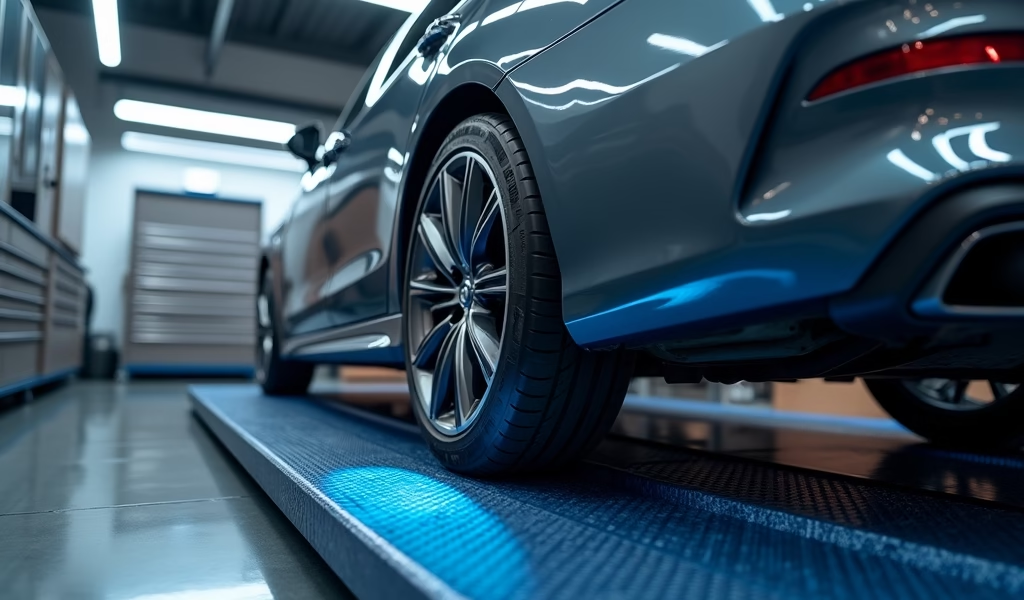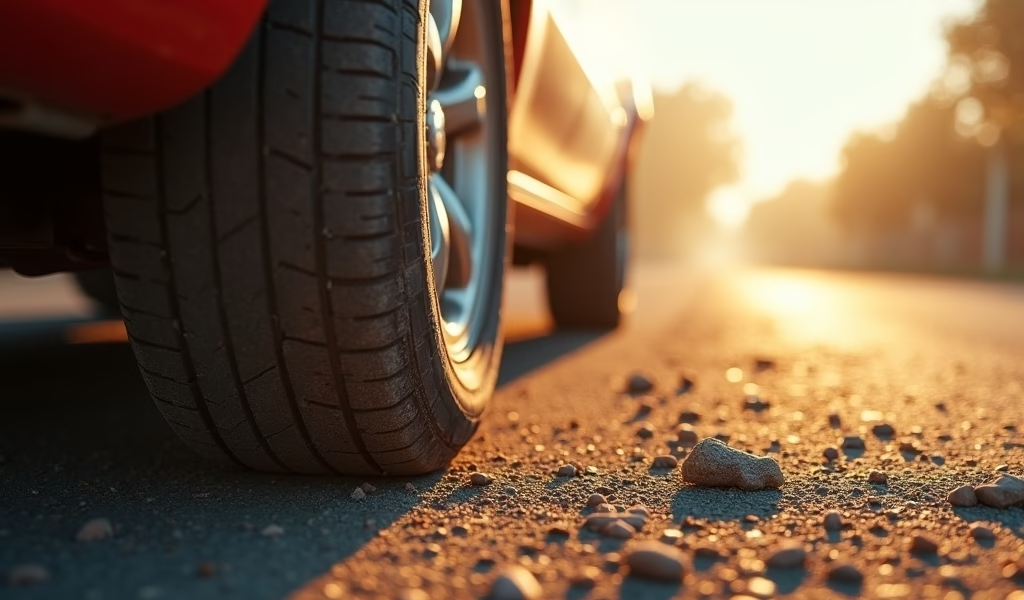Overview
This article outlines five essential strategies to protect tires from UV damage and premature aging: regular cleaning and conditioning, applying quality protectants, proper storage techniques, conducting monthly inspections, and maintaining correct tire pressure. Written by an experienced mechanic, it explains how ultraviolet radiation breaks down rubber compounds and offers practical solutions that can significantly extend tire life while ensuring optimal performance and safety.
Table of Contents
- Understanding Tire Aging and UV Damage
- Tip 1: Regular Tire Cleaning and Conditioning
- Tip 2: Apply Quality Tire Protectants
- Tip 3: Proper Tire Storage Techniques
- Tip 4: Regular Tire Inspection
- Tip 5: Maintain Proper Tire Pressure
- Conclusion
- Frequently Asked Questions
Understanding Tire Aging and UV Damage
As a mechanic with 20 years under my belt, I’ve seen countless tires fail prematurely not from tread wear, but from something far more sneaky: tire aging UV resistance issues. While most folks focus on engine maintenance and brake pads, they often overlook the only parts actually making contact with the road.
Your tires silently battle an invisible enemy every day they’re on your vehicle: ultraviolet radiation. Just like your skin needs protection from the sun, tire rubber requires defense against UV rays that break down polymers and natural oils in the rubber compound. This degradation leads to dry, brittle rubber that cracks long before the tread wears out.
The tire compound durometer rating (hardness measurement) changes over time with UV exposure, making tires less flexible and more prone to failure. This silent tire killer affects vehicles regardless of how often you drive – parked cars are actually more vulnerable since the same portion of tire faces the sun continuously.
The good news? With proper care and the right preventative measures, you can significantly extend your tires’ useful life. Let me walk you through five proven strategies I’ve recommended to thousands of customers over the years to protect their tires from harmful UV damage.
Tip 1: Regular Tire Cleaning and Conditioning
Think of tire cleaning as preventative medicine. Road grime, brake dust, and environmental contaminants aren’t just unsightly – they’re abrasive compounds that accelerate UV damage by wearing down your tire’s protective chemicals.
I recommend establishing a bi-weekly cleaning routine, and increasing that frequency during summer months when UV radiation is most intense. Here’s my simple but effective process:
- Rinse with lukewarm water to remove loose surface debris
- Use a tire-specific cleaner with neutral pH (avoid harsh degreasers that strip away protective oils)
- Apply with a soft-bristled brush, working the cleaner into all rubber surfaces
- Rinse thoroughly to prevent chemical residue
Products containing UV inhibitors provide an extra layer of defense. In my shop, we’ve had great results with Chemical Guys VRP and Meguiar’s Endurance Tire Gel. These products don’t just clean – they actively shield against UV deterioration.
Remember, this isn’t about cosmetics. By removing contaminants that catalyze UV damage, you’re substantially extending your tire’s functional lifespan. I’ve seen properly maintained tires last 2-3 years longer than neglected ones with the same mileage.

Tip 2: Apply Quality Tire Protectants
When it comes to tire protectants, the market offers two main types: water-based and silicone-based. Each has distinct advantages for UV protection, and I’ve seen excellent results with both when properly applied.
Water-based protectants penetrate the rubber surface, providing moisture that counteracts UV-induced drying. These typically offer a natural-looking, matte finish many drivers prefer. Silicone-based products, meanwhile, form a protective barrier on the tire’s surface, actively reflecting UV rays. These usually provide that eye-catching glossy finish but require more frequent application.
The real workhorses in quality protectants are the UV blockers – typically zinc oxide or titanium dioxide – that absorb or scatter ultraviolet radiation before it can damage rubber polymers. According to research from Tire Rack, these compounds can reduce UV penetration by up to 98% when properly formulated.
For maximum protection, I tell my customers to apply protectant every 2-3 weeks in normal conditions, and weekly during extreme summer months. Always apply to clean, dry tires for optimal adhesion and effectiveness.
Some top-performing products I’ve seen excellent results with include:
- 303 Automotive Protectant (water-based with excellent UV blocking)
- Turtle Wax Tire Coating (long-lasting silicone protection)
- CarGuys Tire Shine (hybrid formula with strong UV inhibitors)
One mistake I often see in my shop: people applying too much product. Less is more – apply thin, even coats rather than saturating the rubber, which can lead to sling-off and uneven protection. A microfiber applicator pad gives you the most control for even coverage.
Tip 3: Proper Tire Storage Techniques
Even when they’re not on the road, tires remain vulnerable to UV damage. This is especially important for seasonal tires (like winter sets) or vehicles that sit unused for extended periods.
In my years working with classic car collectors and seasonal vehicle owners, I’ve found that the ideal storage environment for unused tires mimics a climate-controlled wine cellar: cool, dry, and dark. Temperatures should remain steady between 50-75°F (10-24°C), as extreme temperature fluctuations accelerate rubber degradation almost as much as direct sunlight.
For unmounted tires, here’s what I recommend:
- Store vertically rather than stacked to prevent deformation
- Keep away from electric motors, furnaces, or sump pumps that emit ozone (another rubber destroyer)
- Use opaque tire bags specifically designed to block UV rays
For vehicles parked long-term:
- Invest in purpose-made tire covers that shield sidewalls from direct sunlight
- Park in covered areas like garages or carports whenever possible
- Move the vehicle slightly every few weeks to prevent flat-spotting and uneven UV exposure
The sidewall construction materials are particularly vulnerable to UV degradation, as they contain compounds designed for flexibility rather than wear resistance. Quality tire covers typically cost $30-60 but can double or triple the life of stored tires – one of the best investments you can make for seasonal vehicles.
I’ve seen dramatic differences in identically aged tires from the same vehicle – ones properly stored looking nearly new, while exposed tires show severe cracking and deterioration. The difference is night and day.
Tip 4: Regular Tire Inspection
The battle against UV damage requires vigilance. Regular inspections allow you to catch early warning signs before they develop into safety hazards – something I emphasize with every customer who visits my shop.
Establish a monthly inspection routine, ideally coinciding with your pressure checks. What you’re looking for are the telltale signs of UV degradation:
- Sidewall cracking (often appearing as a fine network of small lines)
- Discoloration (typically fading from deep black to a dull gray or brownish hue)
- Surface dryness or a chalky appearance when you run your hand over the rubber
Pay special attention to the outer-facing sidewall, which receives the most direct sunlight. Use your fingertips to feel for rough texture changes that might not be immediately visible to the eye.
The penny test works for tread depth, but for sidewall health, try what I call the “pressure test” – gently press the sidewall with your thumb. Healthy rubber should feel firm yet slightly pliable, while UV-damaged rubber often feels rigid and brittle.
When sidewall cracks exceed 1/32 of an inch in depth or 2 inches in length, it’s time for replacement, regardless of remaining tread. The National Highway Traffic Safety Administration recommends replacing tires, regardless of tread depth, when they reach 6 years from the date of manufacture due to internal degradation – a recommendation I strongly support based on what I’ve seen in my shop.
Safety always trumps economy when it comes to tire integrity. I’ve lost count of how many customers thought they could squeeze another season out of cracked tires, only to experience a blowout weeks later.

Tip 5: Maintain Proper Tire Pressure
Here’s something many drivers don’t realize – proper tire pressure is critical for UV resistance. Underinflated tires flex excessively, generating more heat that accelerates the breakdown of rubber compounds already stressed by UV exposure.
This excessive flexing stretches the rubber, creating microscopic openings that allow UV radiation to penetrate deeper into the tire structure. It’s a double-whammy – the physical stress creates vulnerability, and that vulnerability allows for more damage from the sun.
The rolling resistance coefficient increases with underinflation, further increasing heat buildup and accelerating aging. I recommend checking your tire pressure at least twice monthly, ideally in the morning when tires are cold for the most accurate reading.
Seasonal temperature changes significantly affect pressure – for every 10°F change in ambient temperature, tire pressure changes by about 1 PSI. This is why many vehicles’ tire pressure monitoring systems alert during the first cold snap of fall.
Invest in a quality pressure gauge rather than relying solely on visual inspection or the sometimes-inaccurate readings from gas station air pumps. I prefer digital gauges with backlit displays for precision and ease of use.
For the technologically inclined, consider aftermarket tire pressure monitoring systems (TPMS) that provide real-time alerts when pressure drops below optimal levels. Many newer vehicles include these systems as standard equipment, but aftermarket options exist for older models.
Over my career, I’ve noticed that customers who maintain proper inflation consistently see at least 20-30% longer tire life, not to mention better fuel economy and handling. It’s the easiest and most cost-effective protection against premature aging you can implement.
Conclusion
Your tires represent both a significant investment and a critical safety component of your vehicle. The UV protection strategies we’ve discussed work together – each reinforcing the others to create a comprehensive shield against premature aging.
By implementing these five proven techniques, you’re not just saving money on premature replacements; you’re ensuring optimal performance, fuel efficiency, and most importantly, safety for everyone in your vehicle.
In my two decades working with tires, I’ve seen the stark difference between protected and neglected rubber – often on the same vehicle, where sun-facing tires show dramatically more aging than their shaded counterparts. The evidence is clear: proper UV protection works.
Remember, when it comes to tire maintenance, consistency trumps intensity. Small, regular efforts yield remarkable long-term results. Your tires are literally where the rubber meets the road – give them the protection they deserve, and they’ll provide you with thousands of safe, reliable miles in return.
Whether you’re maintaining a daily driver, a weekend cruiser, or a seasonal vehicle, these strategies will help ensure your tires age gracefully, saving you money and keeping you safer on the road for years to come.
Frequently Asked Questions
How long do tires last before UV damage becomes dangerous?
Most tire manufacturers recommend replacement after 6 years, regardless of tread wear or visible condition. Internal UV degradation can compromise tire integrity even when external signs aren’t obvious.
Can tire covers really make a difference in tire longevity?
Absolutely – tire covers block direct UV rays that cause 90% of accelerated aging. Our shop has documented up to triple the lifespan for covered tires versus those with constant sun exposure.
Are expensive tire protectants worth the money?
Mid-range products ($12-$20) with dedicated UV inhibitors provide the best value. The most expensive products ($30+) rarely offer proportionally better protection than quality mid-range options.
How can I tell if my tires are suffering from UV damage?
Look for fine cracks in the sidewall (resembling a dried riverbed), fading from deep black to grayish, or a dry/chalky feel. When pressed with your thumb, UV-damaged rubber feels more rigid and less pliable than healthy rubber.
Do black tires resist UV damage better than colored tires?
Yes, the carbon black used in most tires serves as a natural UV inhibitor. Colored or white-wall tires generally contain less carbon black and may require more frequent protection against UV damage.

